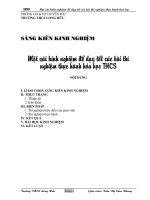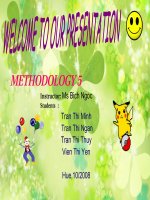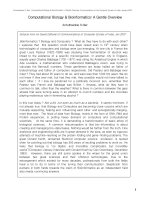Tài liệu Teaching With Animation - a booklet about animation potx
Bạn đang xem bản rút gọn của tài liệu. Xem và tải ngay bản đầy đủ của tài liệu tại đây (6.05 MB, 8 trang )
Teaching
With Animation
- a booklet about animation
Centre for Animation Pedagogics, Leonardo Project - The Animation Workshop 2005
2
Table of contents:
About the project
Why media?
Why animation?
Workshop guidelines
Animation techniques
Te
xt: Hanne Pedersen and Helle Villekold
Text editing: Uffe Danielsen
The Animation Workshop, november 2005
3
5
6
7
4
The project is of two year’s duration and is supported by
the Leonardo programme, an EU education programme. The project
is a cooperation between France, Spain, Estonia, the UK and
Denmark.
The aim of the project is to make teaching with animation an
integrated part of the European school system along with the more
traditional ways of teaching. The inclusion of animation will provide
more variety in the teaching methods and in that way promote
different types of learning.
To obtain this aim, a teacher-training manual will be developed
including didactic considerations and a methodology of how to use
moving pictures, and in this case Animation, as a teaching tool in
the European school system.
The development of the teacher-training manual is based on a close
partnership between animators and researchers.
The teacher-training manual will be based on experiences of
teaching with animation from the countries involved in the project.
These experiences will be evaluated at meetings between the
involved partners throughout the duration of the project. The
results will be publicly displayed on a website.
3
About the project
4
• Children and youngsters spend most of their day in the
company of moving pictures. It is their main source of
information, entertainment and identity.
• Pictures are not only an artistic way of expression – they
have also become an international language.
• To cope with the world of today, the ability to read and
understand pictures and the language of pictures is a
necessity.
• The language of pictures also contains inclusion because it
includes people who are academically weak and provides
them with an alternative way of expression.
• In the modern information and communication society
of today, people are working with idea and concept and the
expectations to creativity are high.
• The copyrights for the moving pictures will be an article in
increasing great demand. For instance, with the game
industry.
The above should be reflected in the European school system.
The fast technical development has created a gap between
intentions and practical possibilities. Due to this consequence,
a great number of teachers in schools have not had the
possibility of getting acquainted with moving pictures through
their training.
Furthermore, there are no traditions or pedagogies in this field,
which is why the development of a teacher-training manual
including didactic and methodology for using the moving
picture’s language is crucial.
Why Media?
5
For the past 20 years, the technical conditions for including
moving pictures as a way of teaching in the European school
system have been present – and the increasing technical
development is continuously making it easier.
The reason why moving pictures still does not play a significant part
in the teaching methods is the lack of pedagogic, methodology, and
the required training of the teachers. The training should provide
the teachers with the necessary basic knowledge of the moving
pictures in order for the teachers to feel comfortable and secure
about using moving pictures in their teaching.
When using the picture language as a teaching method – the
teachers have to choose what type of moving pictures they want
to use; video production, animation etc. Furthermore, there is a
need for a proper approach, a methodology and for a development
of a reader containing the grammar of the picture language. By
introducing this grammar at an early stage- even in the youngest
classes in the primary schools, the pupils will be able to use
pictures in an interdisciplinary way – and in time it will be possible
to hand in an assignment for instance in the shape of an animated
film.
Animation is one type of the moving pictures and animation has the
following advantages:
• Animation is popular among children
• With animation no after-editing is necessary
• Animation makes it possible to be in control of the film because
one works on each picture on the filmstrip – each move and cut
is planned thoroughly which makes it possible to reflect and
analyse.
• Animation can be included in a regular teaching situation
because it does not take up a lot of space.
• Animation and imagination are closely connected which makes
it possible to use animation even with the youngest pupils
• Animation makes “moving in time” easy.
• An animation production can combine the physical and the
virtual worlds.
• Animation strengthens the creative mind.
Why Animation
The aim is that the pupils are able to transform the knowledge and
methodology they have achieved with animation to other learning
processes such as video productions and essay writing. Through
the work with animation, the children will get to know storytelling,
create an awareness of the moving picture language, and develop
an ability to distinguish critically. Animation includes different types
of aesthetic learning processes and is best suited for process-
oriented teaching methods.
Teaching with animation will include the following:
Method – the process behind animation:
o Idea, story
o Synopsis
o Storyboard
o Backgrounds
o Character designs
o Animation
o Sound
Technical subjects:
• Dramaturgy
• Picture composition
• Picture telling
• Cut out techniques
• Modelling
• Animation
• IT
Education:
• Personal development
• Collection of knowledge
• Communication
• Analysis
• Reflection
Software suggestions:
Almost all types of editing programmes can be used to record
pictures one by one to be shown as a short film. In programmes
that are not specialized in animation, it is often a question of
giving the pictures the correct title so that the programme knows
that the pictures should be displayed as a film. In theses types of
programmes, it is important to save often.
One of the aims of this project is to test different types of software
in order to find the simplest one and include this software in the
teacher-training manual.
The following software is suggested by the promoter:
• Stop Motion Pro
• Penicol
• Super 8
Workshop guidelines
6
Animation is a graphical, artistic way of expression. It is possible to
make a very personal mark where only the imagination sets the limit.
The choice of technique is up to the participant to decide depending on
which technique is most suitable for the situation.
Examples of techniques:
• Cut out
• Puppet animation
• 2D
• Flash
• 3D
Animation techniques
7
For more information, please contact:
Hanne Pedersen
Tel. +45 87 25 54 17
or
Helle Villekold
Tel. +45 87 25 54 18
The Animation Workshop
Kasernevej 5
8800 Viborg
Denmark









